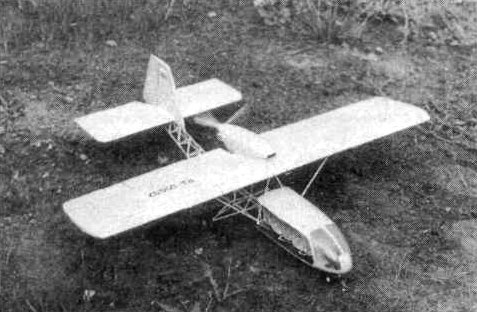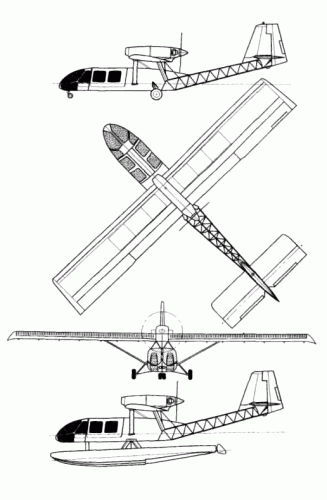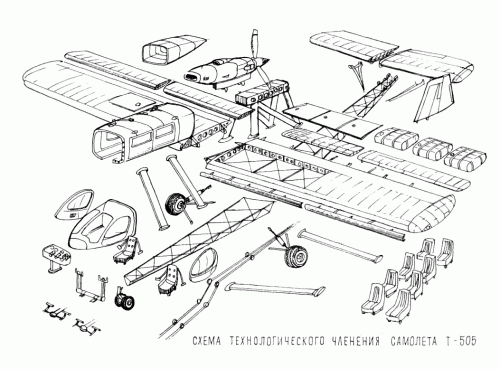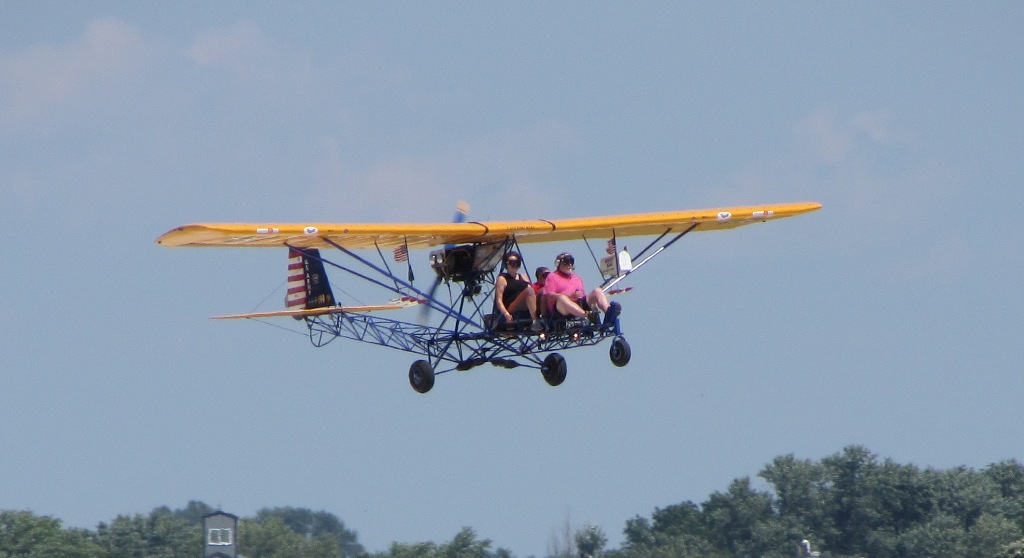- Joined
- 25 June 2009
- Messages
- 13,776
- Reaction score
- 3,045
Under the leadership of Eugene Grunin, Moscow firm Aeroprogress began developing in 1994 its T-505 Strekoza (Dragonfly) an original STOL transport aircraft. The idea was to create a simple machine at low labor costs. The flight characteristics, capacity, ease of use and modular design cabin, all had to compete with modern aircraft of similar purpose in this weight category such as Cessna's Caravan 1, although the latter was not intended for operation from unpaved airfields.
Purpose and missions
The T-505, however can be based both on artificial airfields and unpaved runway areas of limited size. It satisfies the AP-23 and FAR-23 category aircraft norms and is intended to carry loads up to 1,380 kg on routes of up to 1,800 kilometers.
The T-505 is structurally designed on the principle of universality, which makes it easy to switch to other options without changing the basic principle: as a transport for 9-11 passengers, but also for training, sanitary evacuation, patrol, photo-reconnaissance, paratrooping, cargo, tourism and other special applications.
General configuration and design philosophy
The plane is designed with a rectangular braced wing mounted in parasol arrangement, with a turboprop engine and pusher propeller, a tail unit attached to truss fuselage beams, and a fixed landing gear with nose wheel. The machine is equipped with the appropriate radio and navigational equipment, providing flights over water and low-visibility terrain with maximum autonomy.
The main positive feature of the aerodynamic configuration of the T-505 is the presence of TsAGI-type automatic wing slats, slotted ailerons and wingtips. This significantly improves the Strekoza's flying abilities, notably making it safer to fly on all operating angles of attack, with a significant high lift improvement on takeoff and landing using automatic slats and an increase in aerodynamic efficiency.
The excellent flight characteristics, sufficient stability and control are all supported by the results of aerodynamic tests of the aircraft in model form at the Siberian Research Institute of Aviation, and also factory tests of the T-101 Grach, on which construction of the T-505 draws heavily.
The wide range of applications for the aircraft owes to its design, most important the absence of skin on fuselage and a set of easily removable units, allowing you to quickly transform a machine from one version to another in simple steps and with minimal effort.
The T-505 is made with simple technology and with the most affordable and cheap materials. It has low manufacturing complexity, and can be produced in selected plants without complex and expensive equipment. The simplicity of piloting and operation will make this new aircraft accessible to a wide range of professionals and amateurs.
Thanks to this arrangement, the Strekoza provides an easy transition from wheel to ski and float configurations, and an easy switch to other types of engine. When operating from the water the engine is safely protected from splashes.
Construction
The fuselage structure is made of longitudinal girders, transverse and diagonal bracing made from approved "Wings of Motherland" 4.98 7 steel. Both the forward fuselage and tail section are paneled, while the rear fuselage remains a "skeleton". Doors are located on both sides of the fuselage for pilots and passengers.
The wing's longeron is of metal construction and rectangular in plan. The constant chord R-2-14 airfoil is biconvex and unbalanced. In the wings are compartments for fuel tanks. Flaps are positioned at the root of each wing. The horizontal tail consists of a stabilizer and elevator.
The fuel system consists of six tanks, three in each wing, with a capacity of 200-210 liters.
The diagram clearly shows how innovating the design is, although wing mechanical elements, fuel tanks, communication devices, stabilizer and elevator, keel and rudder, controls and fixed landing gear elements are clearly borrowed from the Grach.
Powerplant and equipment
The Strekoza is fitted with a Czech M-601E engine. The Hartzell three-bladed pusher propeller is 2.5 m in diameter, with variable pitch and reversible direction. The power plant also features an anti-icing system.
The aircraft is fitted with fire-fighting equipment. Control of the aircraft is performed through the dual steering wheels and pedals and handlebars for the ailerons. Heating of the cabin and cargo compartment is done by means of the BO-10 heating furnace.
The aircraft is well electrified. Power supply and lighting facilities are designed to supply customers with both direct and alternating current.
The T-505 is provided with modern electronics, navigation and communications equipment. Its sturdy structure makes it possible to operate in bad weather.
Status
The plane is currently being assembled and the prototype will soon be rolled out of the hangar at the airfield. The factory will then begin test flights.
The time for our "Dragonfly" has come, say Aeroprogress designers confidently, stressing that under Russia's current difficult economic conditions, the T-505 could be of similar significance as the Volkswagen was in Germany in the 1930s. Well, maybe...
Specifications
Illustrations by Mikhail Remizov
Freely adapted from Krylia Rodine, April 1998. I do not guarantee a perfect translation, and some hard-to-understand bits were removed, but this should give the general idea.
Purpose and missions
The T-505, however can be based both on artificial airfields and unpaved runway areas of limited size. It satisfies the AP-23 and FAR-23 category aircraft norms and is intended to carry loads up to 1,380 kg on routes of up to 1,800 kilometers.
The T-505 is structurally designed on the principle of universality, which makes it easy to switch to other options without changing the basic principle: as a transport for 9-11 passengers, but also for training, sanitary evacuation, patrol, photo-reconnaissance, paratrooping, cargo, tourism and other special applications.
General configuration and design philosophy
The plane is designed with a rectangular braced wing mounted in parasol arrangement, with a turboprop engine and pusher propeller, a tail unit attached to truss fuselage beams, and a fixed landing gear with nose wheel. The machine is equipped with the appropriate radio and navigational equipment, providing flights over water and low-visibility terrain with maximum autonomy.
The main positive feature of the aerodynamic configuration of the T-505 is the presence of TsAGI-type automatic wing slats, slotted ailerons and wingtips. This significantly improves the Strekoza's flying abilities, notably making it safer to fly on all operating angles of attack, with a significant high lift improvement on takeoff and landing using automatic slats and an increase in aerodynamic efficiency.
The excellent flight characteristics, sufficient stability and control are all supported by the results of aerodynamic tests of the aircraft in model form at the Siberian Research Institute of Aviation, and also factory tests of the T-101 Grach, on which construction of the T-505 draws heavily.
The wide range of applications for the aircraft owes to its design, most important the absence of skin on fuselage and a set of easily removable units, allowing you to quickly transform a machine from one version to another in simple steps and with minimal effort.
The T-505 is made with simple technology and with the most affordable and cheap materials. It has low manufacturing complexity, and can be produced in selected plants without complex and expensive equipment. The simplicity of piloting and operation will make this new aircraft accessible to a wide range of professionals and amateurs.
Thanks to this arrangement, the Strekoza provides an easy transition from wheel to ski and float configurations, and an easy switch to other types of engine. When operating from the water the engine is safely protected from splashes.
Construction
The fuselage structure is made of longitudinal girders, transverse and diagonal bracing made from approved "Wings of Motherland" 4.98 7 steel. Both the forward fuselage and tail section are paneled, while the rear fuselage remains a "skeleton". Doors are located on both sides of the fuselage for pilots and passengers.
The wing's longeron is of metal construction and rectangular in plan. The constant chord R-2-14 airfoil is biconvex and unbalanced. In the wings are compartments for fuel tanks. Flaps are positioned at the root of each wing. The horizontal tail consists of a stabilizer and elevator.
The fuel system consists of six tanks, three in each wing, with a capacity of 200-210 liters.
The diagram clearly shows how innovating the design is, although wing mechanical elements, fuel tanks, communication devices, stabilizer and elevator, keel and rudder, controls and fixed landing gear elements are clearly borrowed from the Grach.
Powerplant and equipment
The Strekoza is fitted with a Czech M-601E engine. The Hartzell three-bladed pusher propeller is 2.5 m in diameter, with variable pitch and reversible direction. The power plant also features an anti-icing system.
The aircraft is fitted with fire-fighting equipment. Control of the aircraft is performed through the dual steering wheels and pedals and handlebars for the ailerons. Heating of the cabin and cargo compartment is done by means of the BO-10 heating furnace.
The aircraft is well electrified. Power supply and lighting facilities are designed to supply customers with both direct and alternating current.
The T-505 is provided with modern electronics, navigation and communications equipment. Its sturdy structure makes it possible to operate in bad weather.
Status
The plane is currently being assembled and the prototype will soon be rolled out of the hangar at the airfield. The factory will then begin test flights.
The time for our "Dragonfly" has come, say Aeroprogress designers confidently, stressing that under Russia's current difficult economic conditions, the T-505 could be of similar significance as the Volkswagen was in Germany in the 1930s. Well, maybe...
Specifications
| (compared with Cessna Caravan 1) | T-505 | Caravan 1 |
| Engine type and power (hp) | M-601E (760) | RT6A-114 (600) |
| Crew | 1 or 2 | 1 or 2 |
| Passengers | 9 to 11 | 9 to 11 |
| Wing span (m) | 17.5 | 15.88 |
| Length (m) | 13.17 | 11.46 |
| Height (m) | 4.56 | 4.3 |
| Empty weight (kg) | 1650 | 1730 |
| Mass of payload (kg) | 1380 | 1360 |
| Max, refueling (kg) | 1000 | 1000 |
| Norms, take-off weight (kg) | 3550 | 3620 |
| Wing loading (kg/m) | 85 | 140 |
| Max, speed (km/h) | 320 | 340 |
| Stall speed (km/h) | 82 | 110 |
| Rate of climb at sea level (m/s) | 9.4 | 6.2 |
| Range (km) | 1800 | 1790 |
| Take-off distance (m) | 325 | 510 |
| Landing distance (m) | 215 | 410 |
Illustrations by Mikhail Remizov
Freely adapted from Krylia Rodine, April 1998. I do not guarantee a perfect translation, and some hard-to-understand bits were removed, but this should give the general idea.




